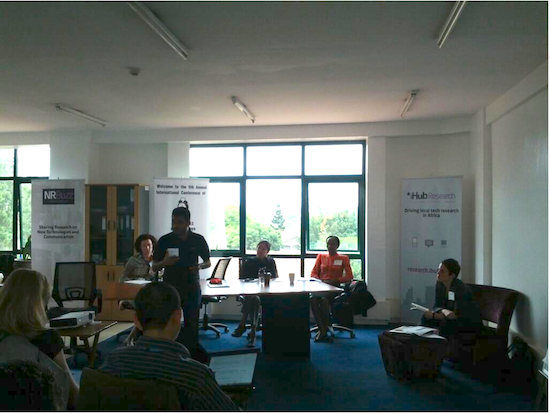
Photo by Heather Leson
Sanjana Hattotuwa, Special Advisor at the ICT4Peace Foundation, delivered a short presentation as part of a panel at the International Conference on Crisis Mappers (ICCM) 2013 training day, held at Nairobi’s iHub.
The panel looked at how to evaluate innovation,
Organizational innovation is not just about generating creative ideas. It is also about supporting ideas in order to identify those which are most likely to become successful innovations. Unfortunately, innovation comes at a price, and that price is the risk of that idea to be not that innovative and in fact not a good idea at all. While Innovation Units in NGOs and Development Organizations are proliferating, we are left with the hard task of figuring out how to evaluate an innovation, keeping in mind that failure is an important part of it. When we decide to try new methodologies, tools and technologies, we need to be able to evaluate those projects in order to understand where the potential lies and what the real impact of that innovation is. In this landscape, research can help us figure out useful frameworks that we can use to make sure we do understand if our projects are successful or not and where we have to invest our energies (and our money).
Sanjana spoke from experience in both architecting initiatives in support of conflict transformation, reconciliation and peacebuilding as well as carrying out various donor funded programmes and projects, largely in the domain of independent media development. He emphasised the importance of looking at process over just the output or end product, noting that often, however innovative the result was, if it didn’t already have community traction, it didn’t last over the longer-term. He spoke around the need to have community driven processes – so that what they wanted to see, collectivity and as a group, drove what was done in order to give life to change processes.
Sanjana talked about the need for donors to be brought into the cycle of innovation, not just as initial funding, but in terms of follow-through and providing the space to fail / knowledge capture within donor funding frameworks.
Sanjana flagged the potential of Minmini News, a SMS based news service by women, for women, from his home country of Sri Lanka, as an example of organic innovation fuelling change.
Sanjana also briefly touched on Moving Images, Mediated and 30 Years Ago, as processes that combined art, culture, architecture, information design, sound, video and photography to communicate, and explore perspectives around protracted conflict, marginalised communities and a epoch-defining pogrom from July, 1983. Innovation, he submitted, wasn’t always in the form of a set of books, frameworks or end products – but revolved around how one could shift the perception of something familiar enough to be apathetic, or even violently opposed to.
Sanjana ended his presentation by noting two key domain challenges around innovation. The art of recognising (and subsequently supporting) innovation, which needed domain, culture and context specific expertise – and importantly, the challenges around supporting organic grassroots innovations which risked community buy-in because of the perception of foreign donor involvement or support. Sanjana also submitted that donors needed to avoid twin tendencies – to implant innovation as they see fit without an organic process than locates innovative practices in a particular context and a tendency to to dismiss innovative policies and practices within a context because it has been done before, elsewhere.
The panel presentation featured some excellent submissions by Jennifer Chan (Harvard Humanitarian Initiative), Hilda Moraa (iHub Research) and Tara Susman-Peña (Internews).
